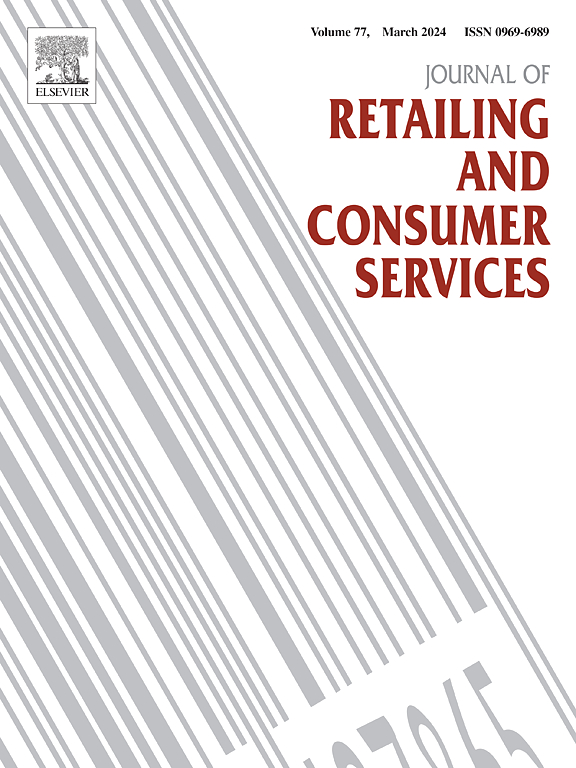消费者的问题作为推动:比较语言线索对LLM聊天机器人和人类反应的影响
IF 11
1区 管理学
Q1 BUSINESS
Journal of Retailing and Consumer Services
Pub Date : 2025-02-04
DOI:10.1016/j.jretconser.2025.104250
引用次数: 0
摘要
大型语言模型(llm)支持自然语言交互,为电子商务中的个性化消费者参与提供了很大的潜力。虽然之前的研究已经探讨了聊天机器人的表达如何影响消费者,但他们往往忽视了消费者作为沟通者的角色,他们通过战略性的语言使用来塑造互动。此外,有证据表明,问题提示可以促使人类做出不同的反应,但LLM聊天机器人是否也能适应这些提示,仍未得到充分研究。根据轻推理论,本研究提出消费者可以策略性地使用问题线索来轻推LLM聊天机器人的响应生成。通过对1419个消费者问题的5676个回答进行语义分析,我们研究了认知和社会情感问题线索对人类和三种LLM聊天机器人(ChatGPT、Claude和GLM)的信息和社会情感反应的影响。研究结果表明,尽管处理机制不同,但问题线索对LLM聊天机器人的推动作用与对SNS用户的推动作用相似。与人类不同,法学硕士聊天机器人表现出一种更明显的倾向,即只关注信息或社会情感反应,很少像人类那样无缝地结合这两个方面。这项研究强调了问题形成在塑造消费者-聊天机器人互动中的重要性,表明聊天机器人在提供一致的信息回应方面优于人类,而不考虑问题的特殊性和情绪,而SNS用户更熟练地处理复杂的情绪问题,显示出它们在电子商务中的互补作用。本文章由计算机程序翻译,如有差异,请以英文原文为准。
Consumers' questions as nudges: Comparing the effect of linguistic cues on LLM chatbot and human responses
Large Language Models (LLMs) enable natural language interactions, offering much potential for personalized consumer engagement in e-commerce. While prior studies have explored how chatbot expressions influence consumers, they often overlook the role of consumers as communicators who shape interactions through strategic language use. Additionally, evidence suggests that question cues can nudge humans to respond differently, but whether LLM chatbots adapt similarly to these cues remains underexplored. Informed by nudging theory, this study proposes that consumers can strategically use question cues to nudge LLM chatbots in response generation. Through a semantic analysis of 5676 responses to 1419 consumers' questions, we investigate the effects of cognitive and socio-emotional question cues on the informational and socio-emotional responses from humans and three LLM chatbots: ChatGPT, Claude and GLM. Findings suggest that, despite differing processing mechanisms, the nudging effect of question cues on LLM chatbots is similar as that on SNS users. Unlike humans, LLM chatbots exhibit a more pronounced tendency to focus exclusively on either informational or socio-emotional responses, rarely combining both aspects as seamlessly as humans do. This research underscores the importance of question formation in shaping consumer-chatbot interactions, suggesting that chatbots outperform humans in providing consistent informational responses regardless of question specificity and emotionality, while SNS users handle complex emotional queries more adeptly, showing their complementary roles in e-commerce.
求助全文
通过发布文献求助,成功后即可免费获取论文全文。
去求助
来源期刊
CiteScore
20.40
自引率
14.40%
发文量
340
审稿时长
20 days
期刊介绍:
The Journal of Retailing and Consumer Services is a prominent publication that serves as a platform for international and interdisciplinary research and discussions in the constantly evolving fields of retailing and services studies. With a specific emphasis on consumer behavior and policy and managerial decisions, the journal aims to foster contributions from academics encompassing diverse disciplines. The primary areas covered by the journal are:
Retailing and the sale of goods
The provision of consumer services, including transportation, tourism, and leisure.

 求助内容:
求助内容: 应助结果提醒方式:
应助结果提醒方式:


